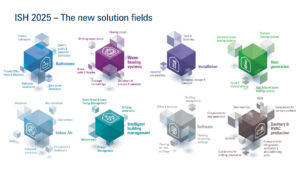Electricity and Heat from the Roof
Solar energy continues to grow in significance with an unmistakable trend towards obtaining electricity and hot water from the sun (photovoltaic and solar thermal energy conversion).
Using the power of the sun, home owners, businesses, industry and the property sector have the chance not only to improve their image but also to cut their operating costs. In view of the increasing prices for electricity, heating oil and natural gas, this aspect is gaining more and more in significance. Attractive promotional measures make the transition to solar energy easier. At the next ISH – International Trade Fair for Building and Energy Technology, The Bathroom Experience, Air Conditioning and Ventilation Technology – in Frankfurt am Main from 15 to 19 March 2005, leading suppliers of solar-energy equipment will provide a comprehensive overview of the multifarious range of products and systems currently available: sophisticated complete solutions for electricity and hot water from the sun.
Rising prices for electricity, heating oil and natural gas are causing feelings to run high. The electricity companies always seem to be jacking up the price of their product. Gas customers are in the middle of a new price spiral. And, according to the Energy Information Service (Energie Informationdienst – EID), Hamburg, heating oil had risen to a new record price for the year and, in Germany, cost an average of 50 cents per litre (for deliveries of 3,000 litres or more) at the beginning of October. This is an increase of about 40 percent over the same time two years ago.
Owners of old and inefficient heating systems are particularly well placed to reduce their dependence on increasing energy prices by modernising their systems and including solar technology. According to a German campaign for solar heating (Initiative Solarwärme Plus, Leipzig): "On average, users of solar energy can save as much as 60 percent on their water-heating costs per year. Larger systems that also support room heating supply between 12 and 25 percent of the total heating energy required."
In combination with modern condensing technology, solar energy can reduce the heating costs of old buildings by between 30 to 50 percent, estimates the Solar Business Association (Unternehmensvereinigung Solarwirtschaft – UVS), Berlin. Around 700,000 home owners in Germany already use solar energy for their hot water and/or heating. According to the German House, Energy and Environment Industrial Association (Bundesindustrieverband Deutschland Haus-, Energie- und Umwelttechnik, BDH), Cologne, every eighth heating-modernisation project includes the installation of a solar-collector system. Nowadays, this is no problem because, in addition to special suppliers, such as Wagner, Paradigma and Solvis, almost all manufacturers in the heating sector (from Bosch/ Buderus, to Stiebel Eltron, via Vaillant and Viessmann) offer products for this prestigious segment of the market as part of their system solutions.
Solar collectors have developed into advanced, high-tech systems that must not only withstand the tough conditions on the house roof but also comply with today's increased expectations in terms of appearance and design. Flat collectors are distinguished by anti-reflection glass and efficient absorber coatings while the latest pipe collectors are characterised by sophisticated mirror and absorber assemblies. Rounding off the range of system products are advanced control systems, special pumps and new storage solutions.
In polls, a large majority of Germans say they regard the sun as a highly environmentally-friendly source of energy. This year was no exception: around three quarters of the people polled told the Allensbach Public Opinion Institute that, in their view, the sun is the best source of energy for the future. Moreover, according to an Emnid poll, no less than 85 percent of the population is in favour of subsidies for renewable energy.
The official policy of promoting solar energy is crucial for the success of this source of power. Thus, consumer interest in solar thermal energy conversion increased significantly during the nineties and reached its provisional peak in 2001: sales rose 45 percent to an area of 900,000 m² of newly-installed collectors. Then, due to a reduction in the subsidies offered, demand fell in 2002 by around 40 percent to around 540,000 m².
However, when the German Ministry of the Environment increased the subsidy paid for collector area installed from € 92 to € 125 per m², the number of applications submitted immediately doubled. The result, according to the Federal Association of the Solar Industry (Bundesverband Solarindustrie, BSi), Berlin, was that demand then climbed back to around 720,000 m².
Although the subsidy was reduced to € 110 / m² as from 1 January 2004, experts still expect a further increase in demand. Thus, at the end of September, UVS General Manager Carsten Körnig estimated that the market for solar thermal energy conversion systems is likely to expand by almost 10 percent this year and reach a collector area of between 750,000 m² and 800,000 m². BDH General Manager Andreas Lücke anticipates growth of at least 10 percent, i.e., to a collector area of between 800,000 m² and max. 850,000 m².
Prognoses for the coming years are difficult. "Should the price of heating oil continue to rise, this could have a stimulating effect on the solar-collector market next year", says Körnig. The aim of his association is to clear the annual hurdle of 1 million square metres of collector area installed as soon as possible.
The fact that solar energy can be used not only to produce hot water but also to generate electricity is reflected by the systems offered by many heating-technology manufacturers. Thus, they offer the sanitation, heating and air-conditioning trade a variety of products with photovoltaic modules from, for example, Sharp, BP Solar, Kyocera and Shell Solar, for this increasingly interesting segment of the market. Thanks to the current promotional measures, photovoltaic systems are enjoying a wave of popularity. There had been a sharp rise in the number of loan applications before Germany's solar-energy programme for 100,000 roofs came to an end in June 2003. According to BSi, new solar-cell installations with a peak output of approx. 130 MW had been fitted by the end of 2003. This is a significant increase on the previous two years (80 MW per year) and a ten-fold jump compared to the end of the nineties.
A further increase in demand came from the improved price currently paid for solar power and gives ground to hope that the 200 MW mark will soon be reached. According to information from UVS, installations that go into operation for the first time in 2004, can earn between 45.7 and 62.4 cents per kilowatt hour supplied to the network (new installations that go into operation in the following years will be subject to a tapering scale of payments).
Although the German photovoltaic industry doubled its output in 2003, shortages still occurred. According to BSi, the monthly production rate was doubled again in the fist half of this year. Following the coming enactment of the new Renewable Energy Law (Erneuerbare-Energien-Gesetz – EEG), both BSi and UVS upped their prognoses in August. Now, the sector expects the market for new installations to grow to around 300 MW in 2004, i.e., twice as much as the year before.
As the world's leading international trade fair for building and energy technology from 15 to 19 March 2005, next year's ISH will cover all aspects of solar-energy usage, i.e., from electricity to hot water. Leading manufacturers will present their latest products and system solutions for an efficient and environmentally-friendly supply of energy. Also part of ISH 2005 will be a special show entitled 'Renewables in energetic systems for houses', which will take a close look at a variety of topics including modern photovoltaic systems for use in buildings and solar systems as an integrated part of modern utilities technology.
Source: Messe Frankfurt GmbH







